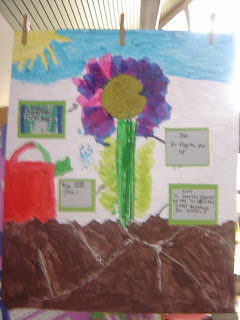Monday, 20 September 2010
Wednesday, 15 September 2010
Home learning
To help you with your home learning this week, here is a link to last year's blog where you will see how the children made their mini rainforests.
http://bsmscarletmacaw.blogspot.com/2009/09/mini-rainforests.html
http://bsmscarletmacaw.blogspot.com/2009/09/mini-rainforests.html
Wednesday, 14 July 2010
Plant Collages
This morning we made collages of plants. We chose and used different textiles and materials to make our plants as realistic as possible.
Then we labelled the parts of the plant and their jobs.
have a look at our brilliant collages:
Then we labelled the parts of the plant and their jobs.
have a look at our brilliant collages:
By Fran I and David
By Emelia, Phoebe and Daniel
By Sophie and Fran B
By Georgina, Emma and Liam
By James, Megan and Ben
By Chloe, Jessica and Jack H
By Charlie, Matthew and Jack B
By Steven, Bethany and Sammy.
Please come into class and see them. Also ask us about the parts of a plant and their jobs because we know them very well!
plant game!
Hello Scarlet Macaws!
Here is that game you were asking me to put on for you! Have fun.
Mrs Collin x
http://www.bbc.co.uk/schools/ks2bitesize/science/living_things/help_plants_grow/play.shtml
Here is that game you were asking me to put on for you! Have fun.
Mrs Collin x
http://www.bbc.co.uk/schools/ks2bitesize/science/living_things/help_plants_grow/play.shtml
Plant stems
We learnt about the parts of the plant and their jobs. One of the jobs of the stem is to transport the water and nutrients that the roots suck up form the soil to the other parts of the plant. To see this happening we have carried out an investigation using celery and food colouring.
We looked carefully at a piece of celery and discovered that it has tiny holes in it that we think help to transport the water and nutrients. We used magnifying glasses to see this more clearly.
We then put the stems of celery into pots with water and food colouring and have left them overnight to see what happens.
We made our own predictions based on our scientific knowledge. What do you think will happen?
We looked carefully at a piece of celery and discovered that it has tiny holes in it that we think help to transport the water and nutrients. We used magnifying glasses to see this more clearly.
We then put the stems of celery into pots with water and food colouring and have left them overnight to see what happens.
We made our own predictions based on our scientific knowledge. What do you think will happen?
Looking at the parts of a plant
What an exciting afternoon we had yesterday! As part of our work on plants we looked at real plants to observe the different parts.
We very carefully teased the soil away from the roots of the plant. We were amazed at the length of the roots. We measured them and discovered that they were longer than the plants themselves.
We then carefully sketched the plants and labelled the parts of the plant and stated their jobs.
We had a great time examining the plants and gained so much knowledge.
We very carefully teased the soil away from the roots of the plant. We were amazed at the length of the roots. We measured them and discovered that they were longer than the plants themselves.
We then carefully sketched the plants and labelled the parts of the plant and stated their jobs.
We had a great time examining the plants and gained so much knowledge.
Mrs Collin has now taken the plants home and planted them in pots for her garden. How lucky is she? She has called them her Scarlet Macaw Plants!
Plants for food
We are now looking at helping plants to grow.
We discussed what plants we grew for food - there were lots of suggestions!
We are lucky to have the allotments in the school grounds so we went to visit them to see some growing plants. We wrote down which plants wee there, made careful observations and drew them. There were lots of questions being asked and it was very interesting. Some of the children talked about their own vegetable patches and allotments.
We discussed what plants we grew for food - there were lots of suggestions!
We are lucky to have the allotments in the school grounds so we went to visit them to see some growing plants. We wrote down which plants wee there, made careful observations and drew them. There were lots of questions being asked and it was very interesting. Some of the children talked about their own vegetable patches and allotments.
Subscribe to:
Comments (Atom)




















